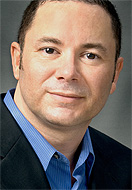Close Up
Soto-Crespo explores transnational focus and bugarron culture
-
 Print
Print -
 Comments
Comments
-

“This is what is happening in cities. People are leaving behind enclosed communities and moving to more integrated areas.”
The Division of Transnational Studies may have just dawned with the fall semester, but it already is finding its place in the world, according to Ramon Soto-Crespo, associate professor of American studies, College of Arts and Sciences.
What was formally known as the Department of American Studies has now come under the Transnational Studies umbrella, along with the departments of African and African American Studies and Global Gender Studies, and the programs in Canadian, Caribbean Cultural, Latino and Polish Studies.
“We’re trying to create an intellectual, cohesive body of scholarship under that type of umbrella,” explains Soto-Crespo, director of Latino studies, who recently hosted the first symposium under the new banner bringing two leading speakers on transnational studies. With a turnout of more than 200 for the symposium, Soto-Crespo feels the new identity is being embraced.
“One of the primary goals was to make Latino studies more visible but also more integrated into a larger intellectual group in part of a larger community, not to be isolated,” he says. “We figured out a way now with Transnational Studies because it focuses on social history, migration issues, issues of American citizenship, diversity and equality, and less on what makes some people feel that they are a group apart, such as language, which sometimes can be very divisive. I think by approaching the positive, rather than the negative element, Transnational Studies is the way to go.”
Soto-Crespo, who teaches Latino and Caribbean literature and culture, and queer, cultural and psychoanalytic theory, has found a growing interest from students looking for a more multicultural, ethnic-studies approach, blending African American or Asian American with Latino culture. “This is what is happening in cities. People are leaving behind enclosed communities and moving to more integrated areas.”
Because assimilation has occurred in their communities, students also are more interested in their heritage, Soto-Crespo points out. “They want to know where they’re coming from and other people are curious as to who these people are and where do they come from. So you have both of those things working together and making the courses and disciplines quite interesting.”
Hailed for his writing—Soto-Crespo’s first book, “Mainland Passage: The Cultural Anomaly of Puerto Rico,” won honorable mention from the prestigious Modern Language Association—he is at work on his second book, with the assistance of a Humanities Institute fellowship.
“Biotropics” examines a hitherto unexplored area of sexual identity in Latino/American culture, a facet unique to Latin American male sexuality.
“For a long time, some males could have sex with other males but not be considered homosexual or gay if they were the top person. In other words, if they didn’t get penetrated sexually, then they weren’t gay or homosexual. They were still heterosexual. The term for them is bugarron,” he says.
Being a bugarron was considered to be endowed with more virility and masculine power, earning a certain stature for those individuals in their society, Soto-Crespo says.
In the traditional Latin American landscape before the 1960s, homosexuality was definitely taboo and people were never able to express their homosexuality openly. That perception started to change with globalization and with the civil rights and gay movements as people began asserting their sexual identity and advocating equal rights, according to Soto-Crespo. “Bugarron then started to be culturally challenged by society, with people arguing that bugarron was a practice cloaking or masking homosexuality,” he notes. “By the 1980s, you started to see people not using the term that much and people distancing themselves.”
There is a new twist to the bugarron practice that Soto-Crespo is now exploring. “There is an incredible tourist industry in the Caribbean that Americans take advantage of every winter,” explains Soto-Crespo. “Gay people do as well and want something different. Sexual tourism exploded in places like the Dominican Republic, where straight people go to have sex. Gay people also want to experience that, but they don’t want to have sex with gay people. They want to have an exotic element—the bugarron. So in recent years, the bugarron has become a most lucrative business.”
The bugarron practice was revived by people who have been left behind by American industries that once were taking advantage of the labor force in the Dominican Republic, but then left for China for much cheaper labor. With unemployment rampant, Dominican Republic males discovered the tourist trade for bugarron services.
“These were people who happened to stumble upon the situation and the word then spread that if you please these tourists, you can earn a lot of money. These are definitely people who are not gay. These are people with families. In some homes, the wife knows, the kids know,” Soto-Crespo explains.
“Biotropics” will examine bugarron sexuality in anthropological, sociological, cultural studies, film and literary works. He expects the project to be completed by the end of 2012.
A native of Puerto Rico, Soto-Crespo relishes his UB experience and life in Buffalo. Since moving to a downtown loft this past year and taking a daily Metro commute to campus, he is experiencing a totally different side of Buffalo. “It’s a complete urban experience,” he says. “It feels like a real city and feels very safe.”

Reader Comments